belt MERCEDES-BENZ R-Class 2011 W251 Owner's Manual
[x] Cancel search | Manufacturer: MERCEDES-BENZ, Model Year: 2011, Model line: R-Class, Model: MERCEDES-BENZ R-Class 2011 W251Pages: 364, PDF Size: 16.5 MB
Page 7 of 364
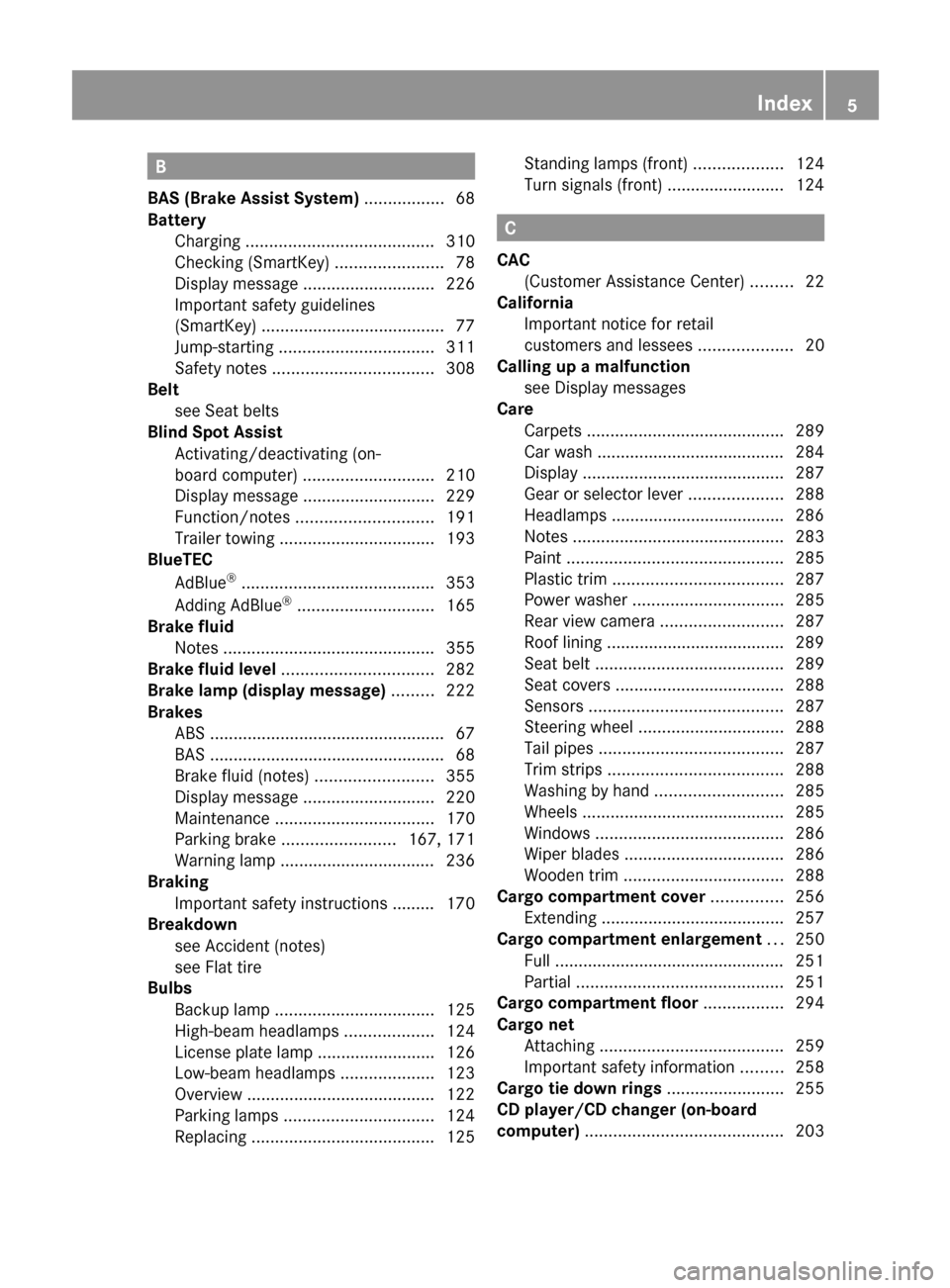
B
BAS (Brake Assist System) ................. 68
Battery Charging ........................................ 310
Checking (SmartKey) .......................78
Display message ............................ 226
Important safety guidelines
(SmartKey) ....................................... 77
Jump-starting ................................. 311
Safety notes .................................. 308
Belt
see Seat belts
Blind Spot Assist
Activating/deactivating (on-
board computer) ............................ 210
Display message ............................ 229
Function/notes ............................. 191
Trailer towing ................................. 193
BlueTEC
AdBlue ®
......................................... 353
Adding AdBlue ®
............................. 165
Brake fluid
Notes ............................................. 355
Brake fluid level ................................ 282
Brake lamp (display message) ......... 222
Brakes ABS .................................................. 67
BAS .................................................. 68
Brake fluid (notes) .........................355
Display message ............................ 220
Maintenance .................................. 170
Parking brake ........................ 167, 171
Warning lamp ................................. 236
Braking
Important safety instructions ......... 170
Breakdown
see Accident (notes)
see Flat tire
Bulbs
Backup lamp .................................. 125
High-beam headlamps ...................124
License plate lamp .........................126
Low-beam headlamps ....................123
Overview ........................................ 122
Parking lamps ................................ 124
Replacing ....................................... 125Standing lamps (front) ...................124
Turn signals (front) ......................... 124
C
CAC (Customer Assistance Center) .........22
California
Important notice for retail
customers and lessees ....................20
Calling up a malfunction
see Display messages
Care
Carpets .......................................... 289
Car wash ........................................ 284
Display ........................................... 287
Gear or selector lever ....................288
Headlamps ..................................... 286
Notes ............................................. 283
Paint .............................................. 285
Plastic trim .................................... 287
Power washer ................................ 285
Rear view camera .......................... 287
Roof lining ...................................... 289
Seat belt ........................................ 289
Seat covers .................................... 288
Sensors ......................................... 287
Steering wheel ............................... 288
Tail pipes ....................................... 287
Trim strips ..................................... 288
Washing by hand ........................... 285
Wheels ........................................... 285
Windows ........................................ 286
Wiper blades .................................. 286
Wooden trim .................................. 288
Cargo compartment cover ............... 256
Extending ....................................... 257
Cargo compartment enlargement ... 250
Full ................................................. 251
Partial ............................................ 251
Cargo compartment floor ................. 294
Cargo net Attaching ....................................... 259
Important safety information .........258
Cargo tie down rings ......................... 255
CD player/CD changer (on-board
computer) .......................................... 203
Index5BA 251 USA, CA Edition A 2011; 1; 3, en-USd2sboikeVersion: 3.0.3.52010-04-16T14:31:55+02:00 - Seite 5
Page 8 of 364
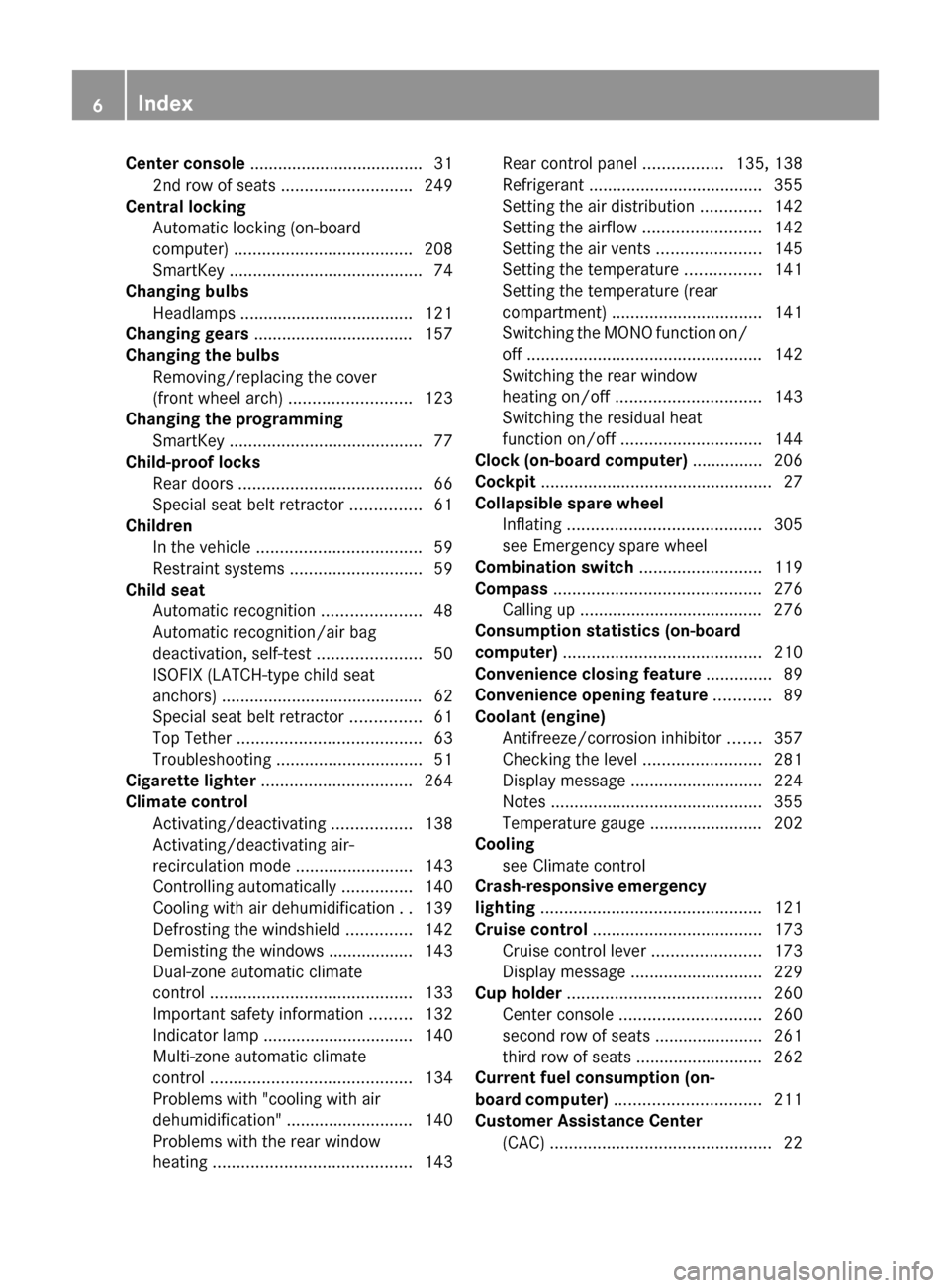
Center console ..................................... 31
2nd row of seats ............................ 249
Central locking
Automatic locking (on-board
computer) ...................................... 208
SmartKey ......................................... 74
Changing bulbs
Headlamps ..................................... 121
Changing gears .................................. 157
Changing the bulbs Removing/replacing the cover
(front wheel arch) .......................... 123
Changing the programming
SmartKey ......................................... 77
Child-proof locks
Rear doors ....................................... 66
Special seat belt retractor ...............61
Children
In the vehicle ................................... 59
Restraint systems ............................ 59
Child seat
Automatic recognition .....................48
Automatic recognition/air bag
deactivation, self-test ......................50
ISOFIX (LATCH-type child seat
anchors) ........................................... 62
Special seat belt retractor ...............61
Top Tether ....................................... 63
Troubleshooting ............................... 51
Cigarette lighter ................................ 264
Climate control Activating/deactivating .................138
Activating/deactivating air-
recirculation mode .........................143
Controlling automatically ...............140
Cooling with air dehumidification ..139
Defrosting the windshield ..............142
Demisting the windows .................. 143
Dual-zone automatic climate
control ........................................... 133
Important safety information .........132
Indicator lamp ................................ 140
Multi-zone automatic climate
control ........................................... 134
Problems with "cooling with air
dehumidification" ........................... 140
Problems with the rear window
heating .......................................... 143Rear control panel .................135, 138
Refrigerant ..................................... 355
Setting the air distribution .............142
Setting the airflow .........................142
Setting the air vents ......................145
Setting the temperature ................141
Setting the temperature (rear
compartment) ................................ 141
Switching the MONO function on/
off .................................................. 142
Switching the rear window
heating on/off ............................... 143
Switching the residual heat
function on/off .............................. 144
Clock (on-board computer) ............... 206
Cockpit ................................................. 27
Collapsible spare wheel Inflating ......................................... 305
see Emergency spare wheel
Combination switch .......................... 119
Compass ............................................ 276
Calling up ....................................... 276
Consumption statistics (on-board
computer) .......................................... 210
Convenience closing feature .............. 89
Convenience opening feature ............ 89
Coolant (engine) Antifreeze/corrosion inhibitor .......357
Checking the level .........................281
Display message ............................ 224
Notes ............................................. 355
Temperature gauge ........................ 202
Cooling
see Climate control
Crash-responsive emergency
lighting ............................................... 121
Cruise control .................................... 173
Cruise control lever .......................173
Display message ............................ 229
Cup holder ......................................... 260
Center console .............................. 260
second row of seats ....................... 261
third row of seats ........................... 262
Current fuel consumption (on-
board computer) ............................... 211
Customer Assistance Center (CAC) ............................................... 226IndexBA 251 USA, CA Edition A 2011; 1; 3, en-USd2sboikeVersion: 3.0.3.52010-04-16T14:31:55+02:00 - Seite 6
Page 11 of 364
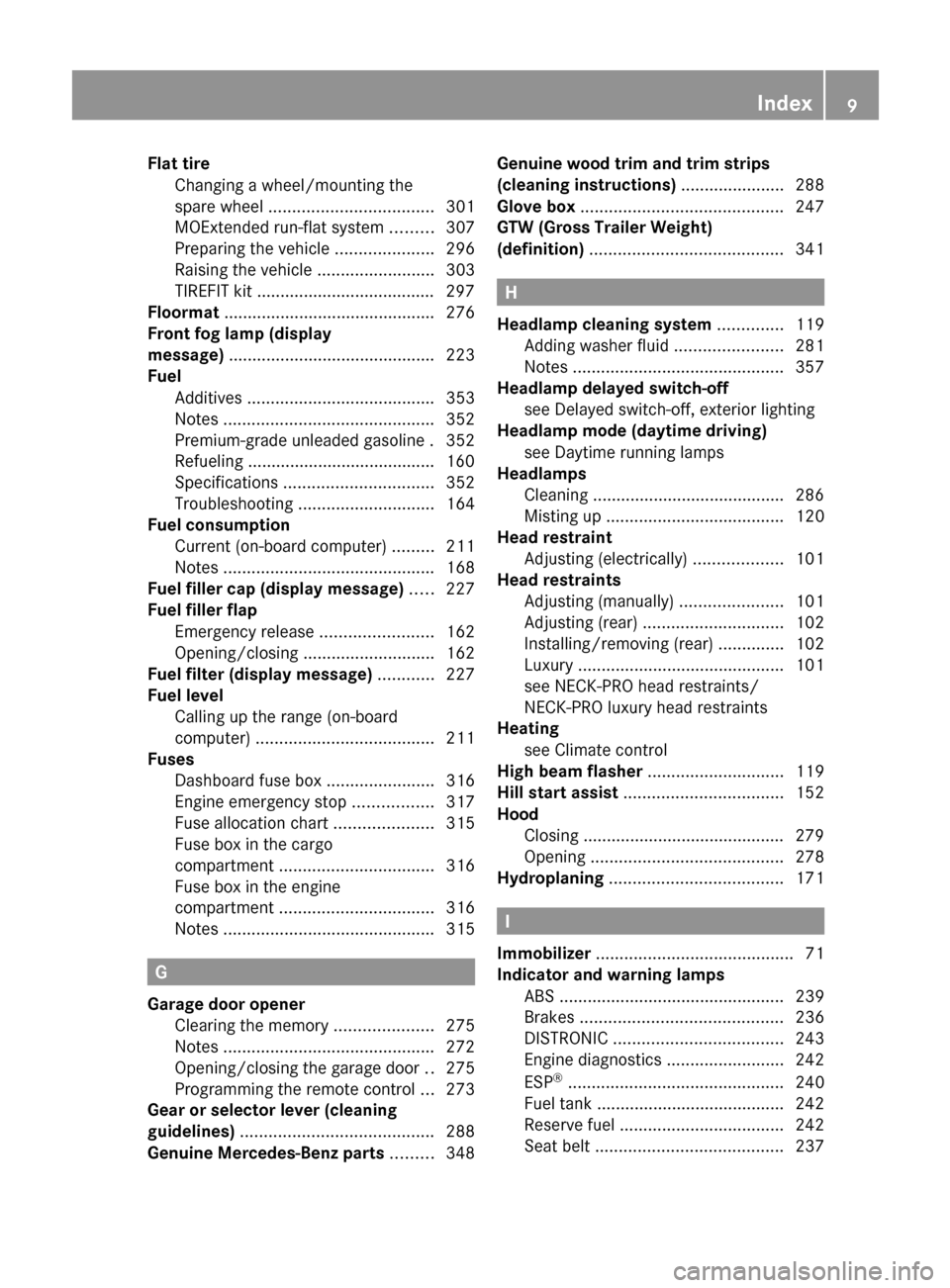
Flat tireChanging a wheel/mounting the
spare wheel ................................... 301
MOExtended run-flat system .........307
Preparing the vehicle .....................296
Raising the vehicle .........................303
TIREFIT kit ...................................... 297
Floormat ............................................. 276
Front fog lamp (display
message) ............................................ 223
Fuel Additives ........................................ 353
Notes ............................................. 352
Premium-grade unleaded gasoline . 352
Refueling ........................................ 160
Specifications ................................ 352
Troubleshooting ............................. 164
Fuel consumption
Current (on-board computer) .........211
Notes ............................................. 168
Fuel filler cap (display message) ..... 227
Fuel filler flap Emergency release ........................162
Opening/closing ............................ 162
Fuel filter (display message) ............ 227
Fuel level Calling up the range (on-board
computer) ...................................... 211
Fuses
Dashboard fuse box .......................316
Engine emergency stop .................317
Fuse allocation chart .....................315
Fuse box in the cargo
compartment ................................. 316
Fuse box in the engine
compartment ................................. 316
Notes ............................................. 315
G
Garage door opener Clearing the memory .....................275
Notes ............................................. 272
Opening/closing the garage door ..275
Programming the remote control ...273
Gear or selector lever (cleaning
guidelines) ......................................... 288
Genuine Mercedes-Benz parts ......... 348
Genuine wood trim and trim strips
(cleaning instructions) ...................... 288
Glove box ........................................... 247
GTW (Gross Trailer Weight)
(definition) ......................................... 341
H
Headlamp cleaning system .............. 119
Adding washer fluid .......................281
Notes ............................................. 357
Headlamp delayed switch-off
see Delayed switch-off, exterior lighting
Headlamp mode (daytime driving)
see Daytime running lamps
Headlamps
Cleaning ......................................... 286
Misting up ...................................... 120
Head restraint
Adjusting (electrically) ...................101
Head restraints
Adjusting (manually) ......................101
Adjusting (rear) .............................. 102
Installing/removing (rear) ..............102
Luxury ............................................ 101
see NECK-PRO head restraints/
NECK-PRO luxury head restraints
Heating
see Climate control
High beam flasher ............................. 119
Hill start assist .................................. 152
Hood Closing ........................................... 279
Opening ......................................... 278
Hydroplaning ..................................... 171
I
Immobilizer .......................................... 71
Indicator and warning lamps ABS ................................................ 239
Brakes ........................................... 236
DISTRONIC .................................... 243
Engine diagnostics .........................242
ESP ®
.............................................. 240
Fuel tank ........................................ 242
Reserve fuel ................................... 242
Seat belt ........................................ 237
Index9BA 251 USA, CA Edition A 2011; 1; 3, en-USd2sboikeVersion: 3.0.3.52010-04-16T14:31:55+02:00 - Seite 9
Page 15 of 364

Rear seatAdjusting ....................................... 103
Rear view camera
Function/notes ............................. 189
Rear view camera (cleaning
instructions) ...................................... 287
Rear-view mirror Anti-glare (manual) ........................111
Dipping (automatic) .......................113
Rear window heating
Malfunction .................................... 143
Switching on/off ........................... 143
Rear window wiper
Replacing the wiper blade .............. 128
Switching on/off ........................... 127
Refueling ............................................ 160
Remote control Programming (garage door
opener) .......................................... 273
Reporting
Malfunctions relevant to safety ........ 23
Reserve fuel
Display message ............................ 227
Warning lamp ................................. 242
Reset button ........................................ 28
Residual heat Switching on/off ........................... 144
Restraint systems
see SRS
Reversing lamp (display message) .. 223
Roadside Assistance (breakdown) .... 20
Roller blind see Roller sunblind
Roller sunblind
Opening/closing .............................. 94
Panorama roof with power tilt/
sliding panel ..................................... 93
Rear side windows .........................263
Roof carrier ................................ 259, 260
Roof lining and carpets (Cleaning
guidelines) ......................................... 289
Route see Route guidance (on-board
computer)
Route guidance (on-board
computer) .......................................... 204S
Safety Children in the vehicle .....................59
Child restraint systems ....................59
Occupant Classification System
(OCS) ............................................... 42
Overview of occupant safety
systems ........................................... 36
Safety systems
see Driving safety systems
Seat
Folding down the 2nd row of
seats .............................................. 252
Folding down the 3rd row of seats . 253
Resetting the 2nd row of seats ......254
Resetting the 3rd row of seats ....... 254
Seat belts
Adjusting the driver's and front-
passenger seat belt .........................56
Adjusting the height ......................... 57
Belt force limiters ............................ 58
Cleaning ......................................... 289
Correct usage .................................. 54
Emergency Tensioning Devices ........ 58
Fastening ......................................... 55
Important safety guidelines .............54
Releasing ......................................... 57
Safety guidelines ............................. 37
Switching belt adjustment on/off
(on-board computer) ......................209
Warning lamp ................................. 237
Warning lamp (function) ................... 57
Seat heating
Indicator lamp (Malfunction) ..........108
Seats
Adjusting (electrically) ...................100
Adjusting (second and third rows) . 103
Adjusting the 4-way lumbar
support .......................................... 107
Adjusting the head restraint ..........101
Cleaning the cover .........................288
Correct driver's seat position ........... 98
Important safety instructions ...........99
Multicontour seat .......................... 107
Storing settings (memory
function) ........................................ 114Index13BA 251 USA, CA Edition A 2011; 1; 3, en-USd2sboikeVersion: 3.0.3.52010-04-16T14:31:55+02:00 - Seite 13
Page 23 of 364

Change of address or ownership
In the event of a change of address, be sure
to send in the "Change of Address Notice"
found in the Service and Warranty
Information Booklet, or simply call the
Mercedes-Benz Customer Assistance Center
(in the USA) at 1-800-FOR-MERCedes
(1-800-367-6372) or Customer Service (in
Canada) at 1-800-387-0100. This will assist
us in contacting you in a timely manner
should the need arise.
If you sell your Mercedes, please leave all
literature with the vehicle to make it available
to the next operator.
If you bought this vehicle used, be sure to
send in the "Notice of Purchase of Used
Truck" found in the Service and Warranty
Information Booklet, or call the Mercedes-
Benz Customer Assistance Center (in the
USA) at 1-800-FOR-MERCedes
(1-800-367-6372) or Customer Service (in
Canada) at 1-800-387-0100.
Vehicle operation outside the USA
and Canada
If you plan to operate your vehicle in foreign
countries, please be aware that:
R Service facilities or replacement parts may
not be readily available.
R Unleaded gasoline for vehicles with
catalytic converters may not be available.
The use of leaded fuels can damage the
catalytic converter.
R Gasoline may have a considerably lower
octane rating. Improper fuel can cause
engine damage.
Sport Utility Vehicle
GWarning
This Sport Utility Vehicle is designed for both
on-road and off-road use. It can go places and
perform tasks for which conventional 2-wheel
drive passenger cars are not intended. This
vehicle will handle and maneuver differently
from conventional passenger cars in driving
conditions which may occur on streets,
highways and off-road use.
This vehicle has a higher ground clearance
and a higher center of gravity than many
passenger cars. As with other vehicles of this
type, if you make sharp turns at excessive
speeds or abrupt maneuvers, the vehicle may
roll over or may go out of control and crash.
Utility vehicles have a significantly higher
rollover rate than other types of vehicles.
Failure to operate this vehicle safely may
result in an accident, rollover of the vehicle,
and severe or fatal injury.
Before you start to drive this vehicle, read the
Operator’s Manual. Take time to become
familiar with the driving characteristics of this
vehicle. Be sure you are familiar with all
vehicle controls. Learn how your vehicle
handles on different road surfaces. Do not
attempt sharp turns at excessive speeds or
abrupt maneuvers or other unsafe driving
actions that can cause loss of vehicle control.
When driving off-road or working the vehicle
hard, do not overload it. And, always wear
your seat belts at all times. In a rollover crash,
an unbelted person is significantly more likely
to die than a person wearing a seat belt.
Operating safety
Safety notes
GWarning
Work improperly carried out on electronic
components and associated software could
cause them to cease functioning. Because the
vehicle's electronic components are
interconnected, any modifications made may
produce an undesired effect on other
systems. Electronic malfunctions could
seriously impair the operating safety of your
vehicle.
Introduction21BA 251 USA, CA Edition A 2011; 1; 3, en-USd2sboikeVersion: 3.0.3.52010-04-16T14:31:55+02:00 - Seite 21Z
Page 31 of 364
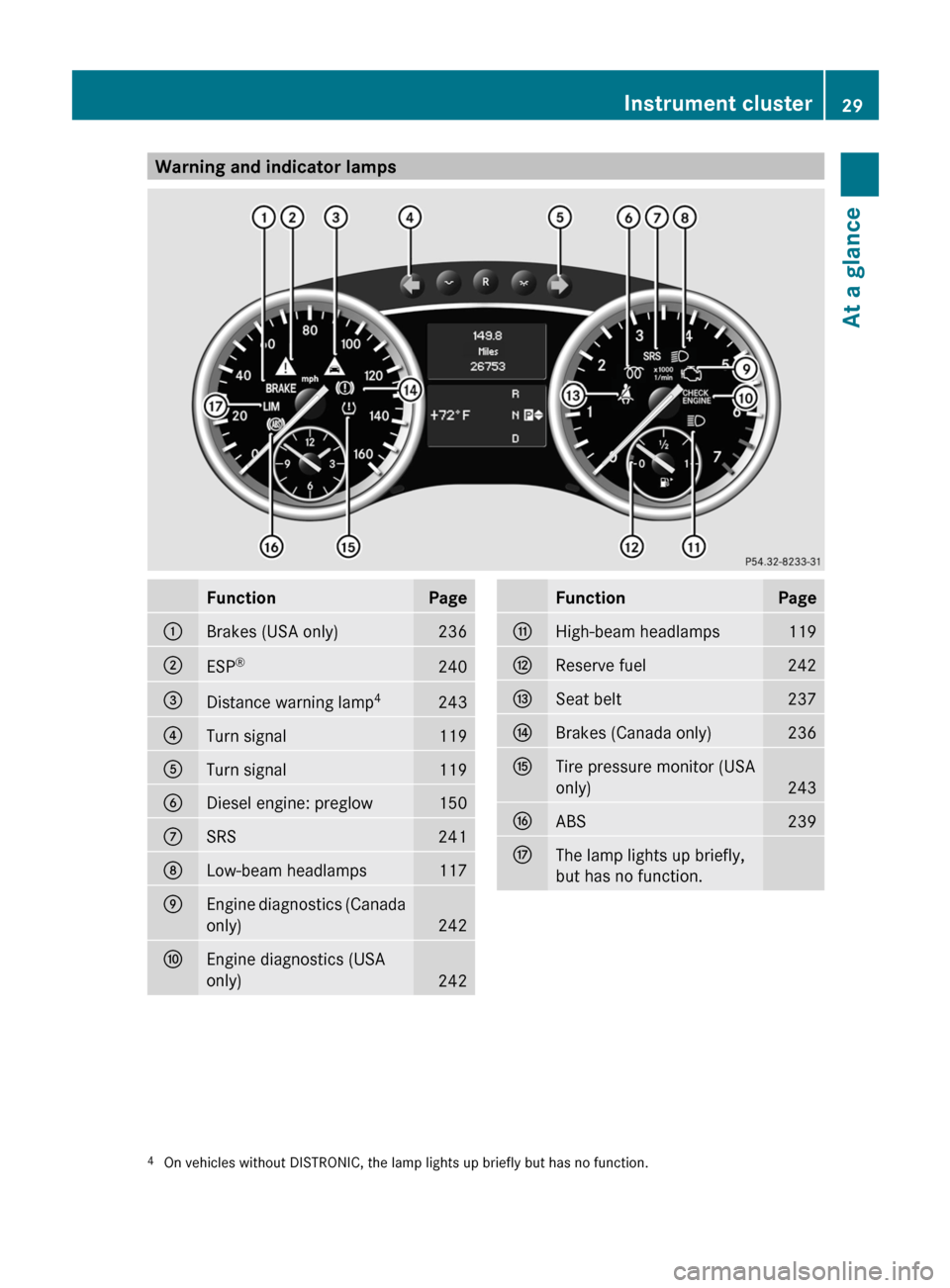
Warning and indicator lampsFunctionPage:Brakes (USA only)236;ESP®240=Distance warning lamp 4243?Turn signal119ATurn signal119BDiesel engine: preglow150CSRS241DLow-beam headlamps117EEngine diagnostics (Canada
only)
242
FEngine diagnostics (USA
only)
242
FunctionPageGHigh-beam headlamps119HReserve fuel242ISeat belt237JBrakes (Canada only)236KTire pressure monitor (USA
only)
243
LABS239MThe lamp lights up briefly,
but has no function.4 On vehicles without DISTRONIC, the lamp lights up briefly but has no function.Instrument cluster29At a glanceBA 251 USA, CA Edition A 2011; 1; 3, en-USd2sboikeVersion: 3.0.3.52010-04-16T14:31:55+02:00 - Seite 29
Page 38 of 364
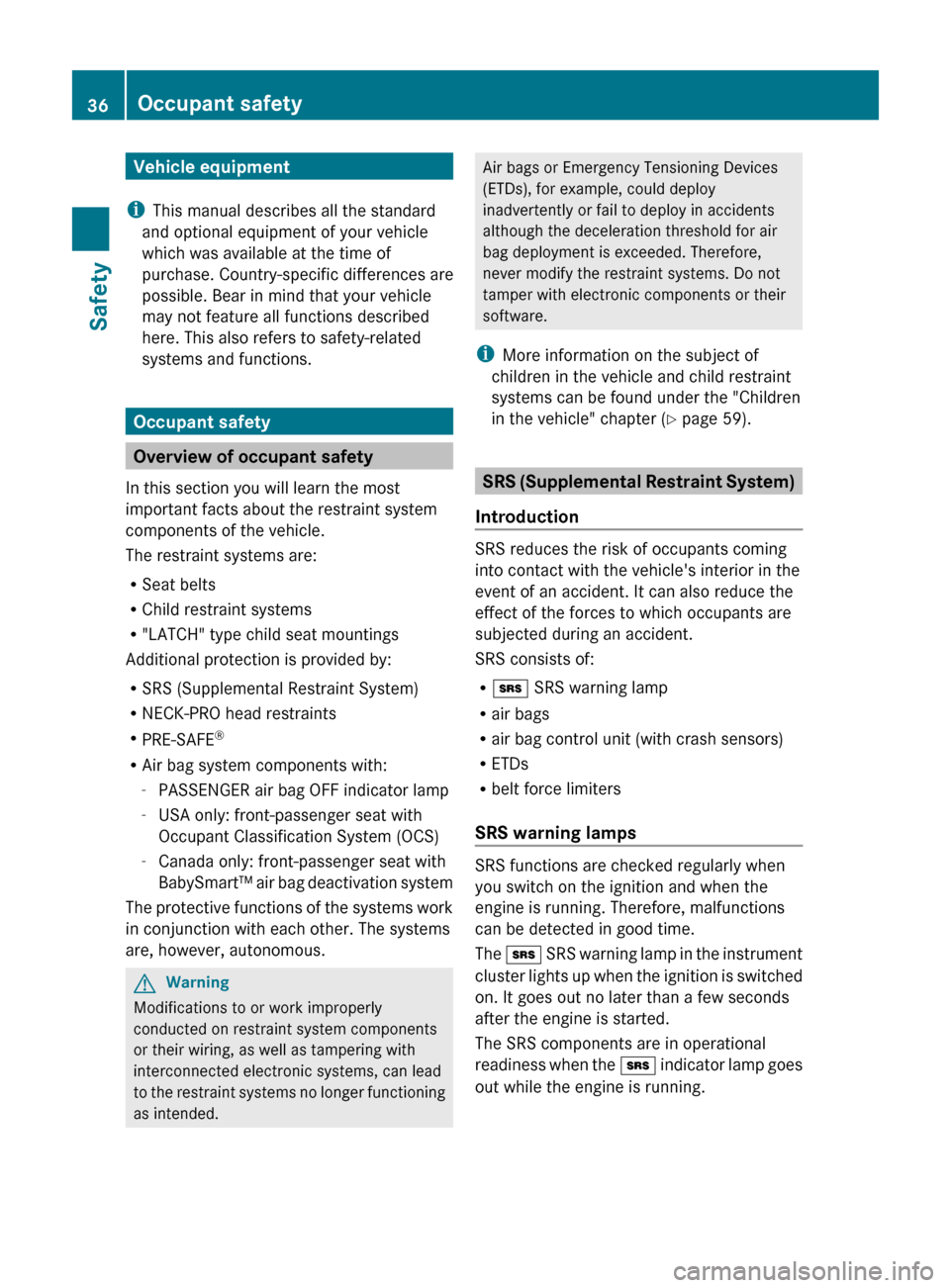
Vehicle equipment
i This manual describes all the standard
and optional equipment of your vehicle
which was available at the time of
purchase. Country-specific differences are
possible. Bear in mind that your vehicle
may not feature all functions described
here. This also refers to safety-related
systems and functions.
Occupant safety
Overview of occupant safety
In this section you will learn the most
important facts about the restraint system
components of the vehicle.
The restraint systems are:
R Seat belts
R Child restraint systems
R "LATCH" type child seat mountings
Additional protection is provided by:
R SRS (Supplemental Restraint System)
R NECK-PRO head restraints
R PRE-SAFE ®
R Air bag system components with:
- PASSENGER air bag OFF indicator lamp
- USA only: front-passenger seat with
Occupant Classification System (OCS)
- Canada only: front-passenger seat with
BabySmart™ air bag deactivation system
The protective functions of the systems work
in conjunction with each other. The systems
are, however, autonomous.
GWarning
Modifications to or work improperly
conducted on restraint system components
or their wiring, as well as tampering with
interconnected electronic systems, can lead
to the restraint systems no longer functioning
as intended.
Air bags or Emergency Tensioning Devices
(ETDs), for example, could deploy
inadvertently or fail to deploy in accidents
although the deceleration threshold for air
bag deployment is exceeded. Therefore,
never modify the restraint systems. Do not
tamper with electronic components or their
software.
i More information on the subject of
children in the vehicle and child restraint
systems can be found under the "Children
in the vehicle" chapter ( Y page 59).
SRS (Supplemental Restraint System)
Introduction
SRS reduces the risk of occupants coming
into contact with the vehicle's interior in the
event of an accident. It can also reduce the
effect of the forces to which occupants are
subjected during an accident.
SRS consists of:
R + SRS warning lamp
R air bags
R air bag control unit (with crash sensors)
R ETDs
R belt force limiters
SRS warning lamps
SRS functions are checked regularly when
you switch on the ignition and when the
engine is running. Therefore, malfunctions
can be detected in good time.
The + SRS warning lamp in the instrument
cluster lights up when the ignition is switched
on. It goes out no later than a few seconds
after the engine is started.
The SRS components are in operational
readiness when the + indicator lamp goes
out while the engine is running.
36Occupant safetySafety
BA 251 USA, CA Edition A 2011; 1; 3, en-USd2sboikeVersion: 3.0.3.52010-04-16T14:31:55+02:00 - Seite 36
Page 39 of 364
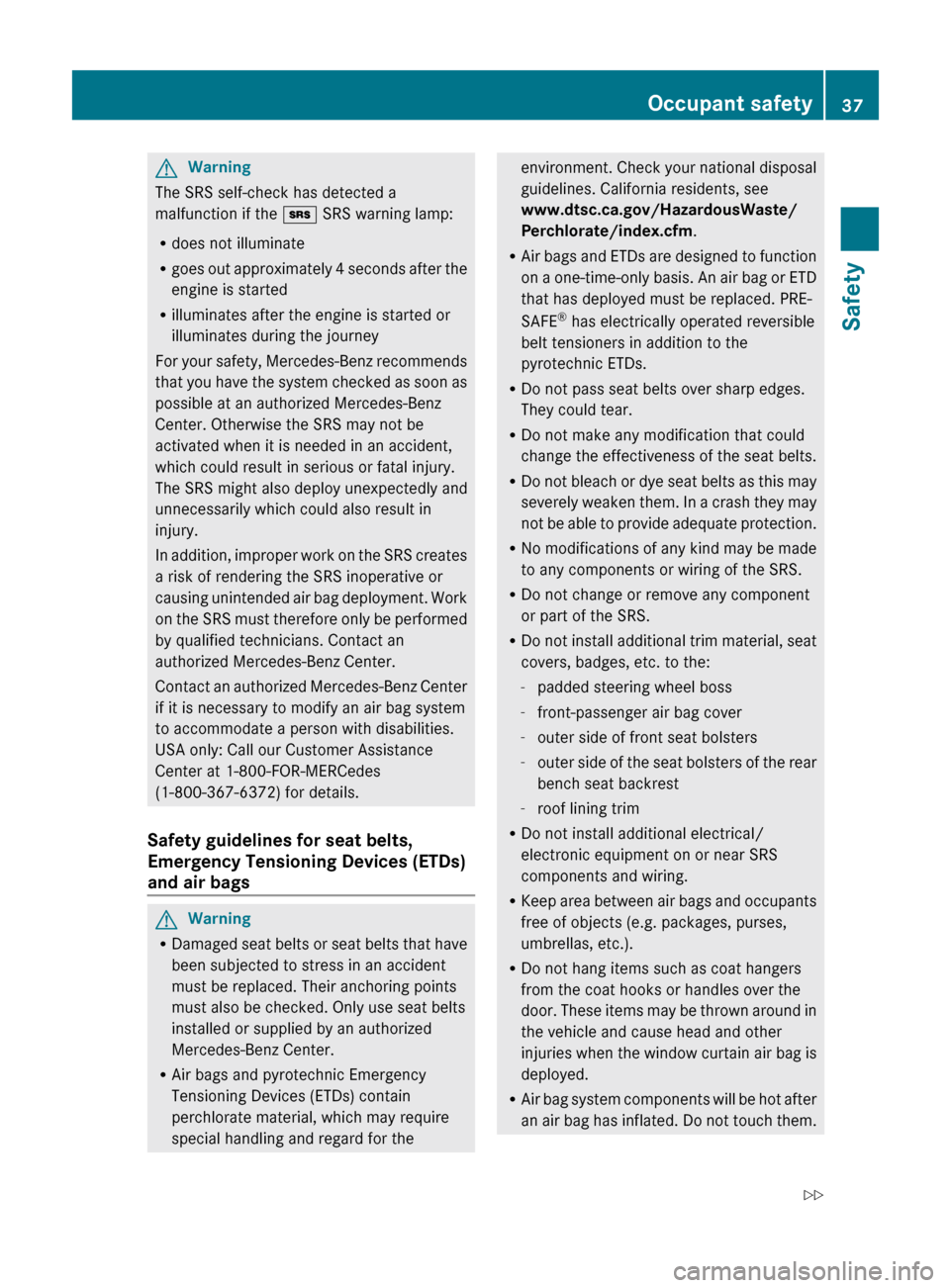
GWarning
The SRS self-check has detected a
malfunction if the + SRS warning lamp:
R does not illuminate
R goes out approximately 4 seconds after the
engine is started
R illuminates after the engine is started or
illuminates during the journey
For your safety, Mercedes-Benz recommends
that you have the system checked as soon as
possible at an authorized Mercedes-Benz
Center. Otherwise the SRS may not be
activated when it is needed in an accident,
which could result in serious or fatal injury.
The SRS might also deploy unexpectedly and
unnecessarily which could also result in
injury.
In addition, improper work on the SRS creates
a risk of rendering the SRS inoperative or
causing unintended air bag deployment. Work
on the SRS must therefore only be performed
by qualified technicians. Contact an
authorized Mercedes-Benz Center.
Contact an authorized Mercedes-Benz Center
if it is necessary to modify an air bag system
to accommodate a person with disabilities.
USA only: Call our Customer Assistance
Center at 1-800-FOR-MERCedes
(1-800-367-6372) for details.
Safety guidelines for seat belts,
Emergency Tensioning Devices (ETDs)
and air bags
GWarning
R Damaged seat belts or seat belts that have
been subjected to stress in an accident
must be replaced. Their anchoring points
must also be checked. Only use seat belts
installed or supplied by an authorized
Mercedes-Benz Center.
R Air bags and pyrotechnic Emergency
Tensioning Devices (ETDs) contain
perchlorate material, which may require
special handling and regard for the
environment. Check your national disposal
guidelines. California residents, see
www.dtsc.ca.gov/HazardousWaste/
Perchlorate/index.cfm .
R Air bags and ETDs are designed to function
on a one-time-only basis. An air bag or ETD
that has deployed must be replaced. PRE-
SAFE ®
has electrically operated reversible
belt tensioners in addition to the
pyrotechnic ETDs.
R Do not pass seat belts over sharp edges.
They could tear.
R Do not make any modification that could
change the effectiveness of the seat belts.
R Do not bleach or dye seat belts as this may
severely weaken them. In a crash they may
not be able to provide adequate protection.
R No modifications of any kind may be made
to any components or wiring of the SRS.
R Do not change or remove any component
or part of the SRS.
R Do not install additional trim material, seat
covers, badges, etc. to the:
- padded steering wheel boss
- front-passenger air bag cover
- outer side of front seat bolsters
- outer side of the seat bolsters of the rear
bench seat backrest
- roof lining trim
R Do not install additional electrical/
electronic equipment on or near SRS
components and wiring.
R Keep area between air bags and occupants
free of objects (e.g. packages, purses,
umbrellas, etc.).
R Do not hang items such as coat hangers
from the coat hooks or handles over the
door. These items may be thrown around in
the vehicle and cause head and other
injuries when the window curtain air bag is
deployed.
R Air bag system components will be hot after
an air bag has inflated. Do not touch them.Occupant safety37SafetyBA 251 USA, CA Edition A 2011; 1; 3, en-USd2sboikeVersion: 3.0.3.52010-04-16T14:31:55+02:00 - Seite 37Z
Page 40 of 364
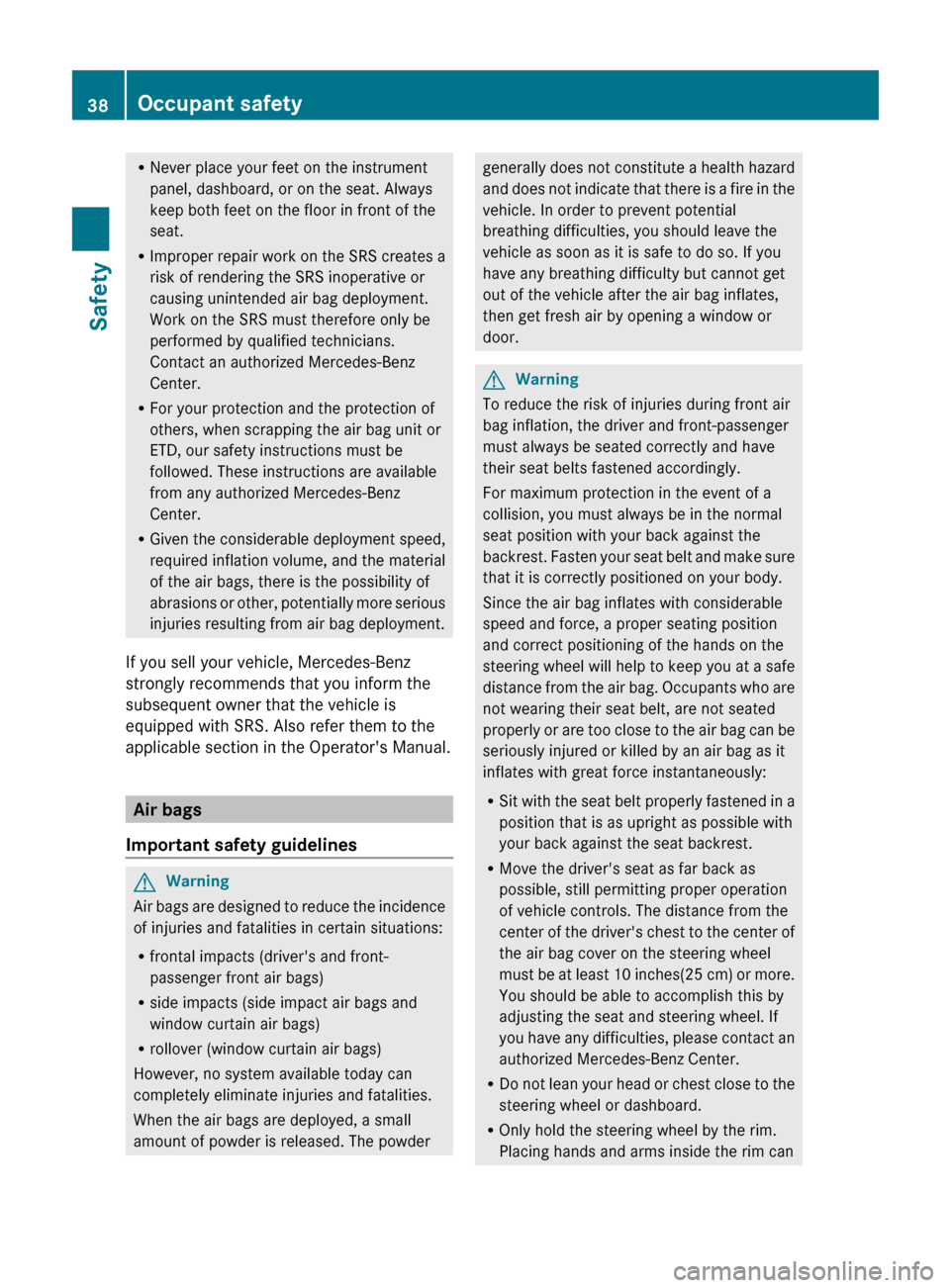
RNever place your feet on the instrument
panel, dashboard, or on the seat. Always
keep both feet on the floor in front of the
seat.
R Improper repair work on the SRS creates a
risk of rendering the SRS inoperative or
causing unintended air bag deployment.
Work on the SRS must therefore only be
performed by qualified technicians.
Contact an authorized Mercedes-Benz
Center.
R For your protection and the protection of
others, when scrapping the air bag unit or
ETD, our safety instructions must be
followed. These instructions are available
from any authorized Mercedes-Benz
Center.
R Given the considerable deployment speed,
required inflation volume, and the material
of the air bags, there is the possibility of
abrasions or other, potentially more serious
injuries resulting from air bag deployment.
If you sell your vehicle, Mercedes-Benz
strongly recommends that you inform the
subsequent owner that the vehicle is
equipped with SRS. Also refer them to the
applicable section in the Operator's Manual.
Air bags
Important safety guidelines
GWarning
Air bags are designed to reduce the incidence
of injuries and fatalities in certain situations:
R frontal impacts (driver's and front-
passenger front air bags)
R side impacts (side impact air bags and
window curtain air bags)
R rollover (window curtain air bags)
However, no system available today can
completely eliminate injuries and fatalities.
When the air bags are deployed, a small
amount of powder is released. The powder
generally does not constitute a health hazard
and does not indicate that there is a fire in the
vehicle. In order to prevent potential
breathing difficulties, you should leave the
vehicle as soon as it is safe to do so. If you
have any breathing difficulty but cannot get
out of the vehicle after the air bag inflates,
then get fresh air by opening a window or
door.GWarning
To reduce the risk of injuries during front air
bag inflation, the driver and front-passenger
must always be seated correctly and have
their seat belts fastened accordingly.
For maximum protection in the event of a
collision, you must always be in the normal
seat position with your back against the
backrest. Fasten your seat belt and make sure
that it is correctly positioned on your body.
Since the air bag inflates with considerable
speed and force, a proper seating position
and correct positioning of the hands on the
steering wheel will help to keep you at a safe
distance from the air bag. Occupants who are
not wearing their seat belt, are not seated
properly or are too close to the air bag can be
seriously injured or killed by an air bag as it
inflates with great force instantaneously:
R Sit with the seat belt properly fastened in a
position that is as upright as possible with
your back against the seat backrest.
R Move the driver's seat as far back as
possible, still permitting proper operation
of vehicle controls. The distance from the
center of the driver's chest to the center of
the air bag cover on the steering wheel
must be at least 10 inches (25 cm) or more.
You should be able to accomplish this by
adjusting the seat and steering wheel. If
you have any difficulties, please contact an
authorized Mercedes-Benz Center.
R Do not lean your head or chest close to the
steering wheel or dashboard.
R Only hold the steering wheel by the rim.
Placing hands and arms inside the rim can
38Occupant safetySafety
BA 251 USA, CA Edition A 2011; 1; 3, en-USd2sboikeVersion: 3.0.3.52010-04-16T14:31:55+02:00 - Seite 38
Page 41 of 364
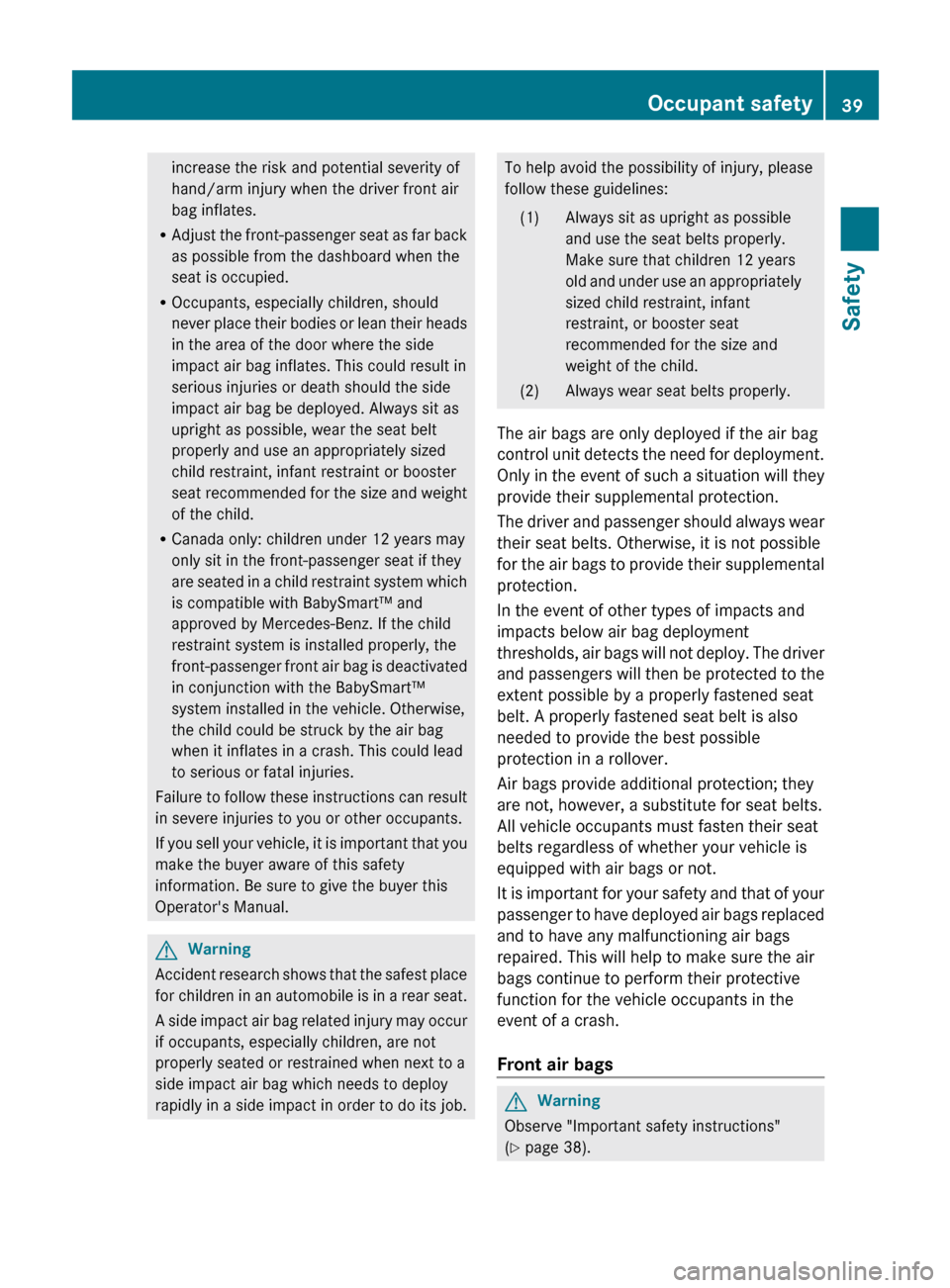
increase the risk and potential severity of
hand/arm injury when the driver front air
bag inflates.
R Adjust the front-passenger seat as far back
as possible from the dashboard when the
seat is occupied.
R Occupants, especially children, should
never place their bodies or lean their heads
in the area of the door where the side
impact air bag inflates. This could result in
serious injuries or death should the side
impact air bag be deployed. Always sit as
upright as possible, wear the seat belt
properly and use an appropriately sized
child restraint, infant restraint or booster
seat recommended for the size and weight
of the child.
R Canada only: children under 12 years may
only sit in the front-passenger seat if they
are seated in a child restraint system which
is compatible with BabySmart™ and
approved by Mercedes-Benz. If the child
restraint system is installed properly, the
front-passenger front air bag is deactivated
in conjunction with the BabySmart™
system installed in the vehicle. Otherwise,
the child could be struck by the air bag
when it inflates in a crash. This could lead
to serious or fatal injuries.
Failure to follow these instructions can result
in severe injuries to you or other occupants.
If you sell your vehicle, it is important that you
make the buyer aware of this safety
information. Be sure to give the buyer this
Operator's Manual.GWarning
Accident research shows that the safest place
for children in an automobile is in a rear seat.
A side impact air bag related injury may occur
if occupants, especially children, are not
properly seated or restrained when next to a
side impact air bag which needs to deploy
rapidly in a side impact in order to do its job.
To help avoid the possibility of injury, please
follow these guidelines:(1)Always sit as upright as possible
and use the seat belts properly.
Make sure that children 12 years
old and under use an appropriately
sized child restraint, infant
restraint, or booster seat
recommended for the size and
weight of the child.(2)Always wear seat belts properly.
The air bags are only deployed if the air bag
control unit detects the need for deployment.
Only in the event of such a situation will they
provide their supplemental protection.
The driver and passenger should always wear
their seat belts. Otherwise, it is not possible
for the air bags to provide their supplemental
protection.
In the event of other types of impacts and
impacts below air bag deployment
thresholds, air bags will not deploy. The driver
and passengers will then be protected to the
extent possible by a properly fastened seat
belt. A properly fastened seat belt is also
needed to provide the best possible
protection in a rollover.
Air bags provide additional protection; they
are not, however, a substitute for seat belts.
All vehicle occupants must fasten their seat
belts regardless of whether your vehicle is
equipped with air bags or not.
It is important for your safety and that of your
passenger to have deployed air bags replaced
and to have any malfunctioning air bags
repaired. This will help to make sure the air
bags continue to perform their protective
function for the vehicle occupants in the
event of a crash.
Front air bags
GWarning
Observe "Important safety instructions"
( Y page 38).
Occupant safety39SafetyBA 251 USA, CA Edition A 2011; 1; 3, en-USd2sboikeVersion: 3.0.3.52010-04-16T14:31:55+02:00 - Seite 39Z